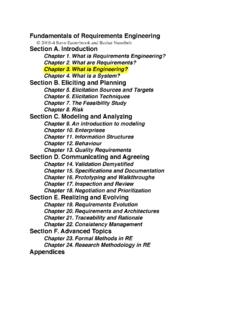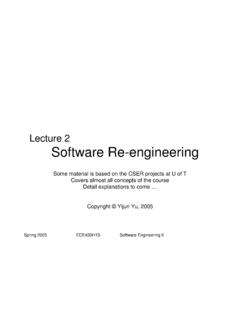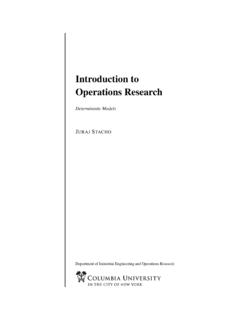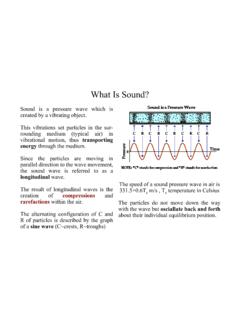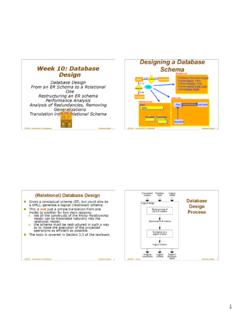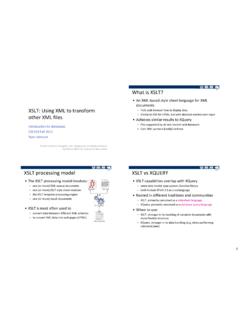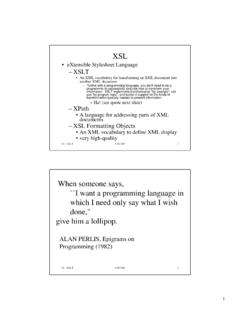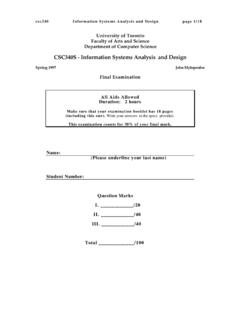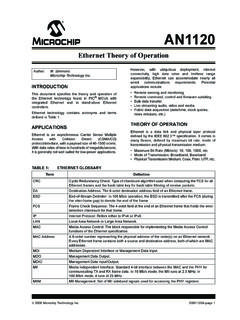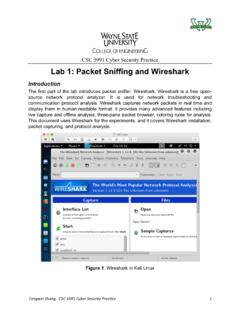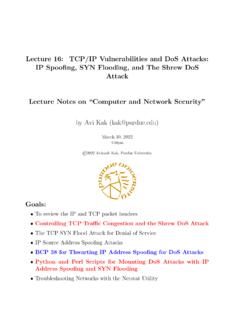Transcription of CSC358 AW3 Solution
1 CSC358 Wireshark Assignment 1 Solution Part I. UDP. 1. Select one UDP packet from your trace. From this packet, determine how many fields there are in the UDP header. (You shouldn't look in the textbook! Answer these questions directly from what you observe in the packet trace.) Name these fields. Solution : UDP header contains 4 fields: 1. source port; 2. destination port; 3. length; 4. checksum 2. By consulting the displayed information in Wireshark's packet content field for this packet, determine the length (in bytes) of each of the UDP header fields. Solution : The UDP header has a fixed length of 8 bytes. Each of these 4 header fields is 2 bytes long. 3. The value in the Length field is the length of what? (You can consult the text for this answer). What is the length of UDP payload for your selected packet. Solution : The length field specifies the number of bytes in the UDP segment (header plus data). An explicit length value is needed since the size of the data field may differ from one UDP segment to the next.
2 The length of UDP payload for selected packet is 32 bytes. 40 bytes - 8 bytes = 32 bytes. 4. What is the maximum number of bytes that can be included in a UDP payload? (Hint: the answer to this question can be determined by your answer to 2. above). Solution : The maximum number of bytes that can be included in a UDP payload is (2^16 1) bytes plus the header bytes. This gives 65535 bytes 8 bytes = 65527 bytes. 5. What is the largest possible source port number? Solution : The largest possible source port number is (2^16 1) = 65535. 6. What is the protocol number for UDP? Give your answer in both hexadecimal and decimal notation. (To answer this question, you'll need to look into the IP header.). Solution : The IP protocol number for UDP is 0x11 hex, which is 17 in decimal value. 7. Examine a pair of UDP packets in which the first packet is sent by your host and the second packet is a reply to the first packet. Describe the relationship between the port numbers in the two packets.
3 Solution : The source port of the UDP packet sent by the host is the same as the destination port of the reply packet, and conversely the destination port of the UDP packet sent by the host is the same as the source port of the reply packet. Part II. TCP. 1. What is the IP address of the client (the initiator of this TCP connection), and what is the server's IP address? From which port the client initiates the connection, and what is the port number used for this connection on the server side? Solution : Client: IP address: Port: 57678. Server: IP address: Port: 80. 2. Roughly speaking, what is the RTT of this connection? (just need a rough number, answer within 10ms will be fine). Roughly how many RTT does it take (in total) for this TCP. connection to establish, tranfer data and close? Solution : The RTT is approximately 47ms. It takes 5 RTT before the connect closes. 3. During the handshaking of this connection, what is the length of the TCP header? Is this TCP.
4 Header the basic one? If not, what is the optional field(s) in the TCP header. Solution : The header length is 40 bytes in handshaking stage. The TCP header is not just the basic one, it has a few optional header fields: Maximum segment size, SACK permitted, Timestamps, NOP, Window scale. 4. Answer 3 after the handshaking stage. What is the length of maximum TCP payload of a packet after this tcp connection is established? Solution : The header length is 32 bytes in established stage. It has Timestamps and 2 NOP as optional headers. The maximum length of payload of a packet in established mode is 1448 bytes (1500 20 IP. header 32 TCP header). 5. How many HTTP data the server sends to the client during the 2nd RTT, 3rd RTT and 4th RTT. (respectively)? Solution : 2nd RTT: 3 packets * 1448 bytes HTTP data each packet = 4344 bytes 3rd RTT: 6 packets * 1448 bytes HTTP data each packet = 8688 bytes 4th RTT: 6 packets * 1448 bytes + 325 bytes = 9013 bytes 6. What is the initial buffer size (window size) advertised by the client?
5 Has the buffer size on the client side ever become the bottleneck during the transferring of data? (Be careful when answer this question, show how you get your conclusion). Solution : The client's initial window size is 5840 bytes. The client's window size has never become the bottleneck. In the 2nd RTT, the client's window size is 5840 bytes from the server's perspective, and the server only sends 3 * 1448 bytes = 4344 bytes < 5840 bytes. In the 3rd RTT, the client's window size is 14592 bytes (the last advertised window size by client in the 2nd RTT), and the server only sends 6 * 1448 bytes = 8688 bytes < 14592 bytes. In the 4th RTT the client's window size is even larger.
